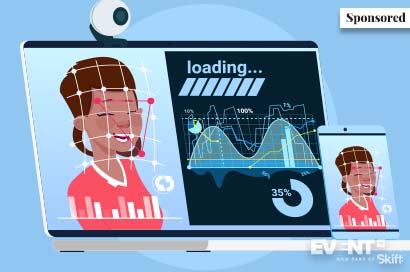This is a sponsored post by Zenus. More information about Event Manager Blog’s sponsored posts.
Over the years, event analytics have proven to be essential for event organizers to understand their audience’s needs and expectations and improve their attendees’ experience. To get these insights, event planners have different tools at their disposal, including questionnaires, surveys, RFID, and Bluetooth technologies. But these methods are not without their limitations.
RFID and Bluetooth technologies still have some barriers, like the cost and complexity of implementation, and the insight they provide is usually limited to counting people and measuring dwell time. Surveys (and particularly post-event surveys) often suffer from low response rates and are not designed to capture insights continuously throughout the event.
But recently, facial analysis technology is emerging as a valuable source of event data that promises to be a practical complement or alternative to some of these other methods. Using computer vision AI, facial analysis removes friction and simultaneously enhances the available information to help you better understand your audience and optimize their experience.
In this article, we are going to cover four benefits of computer vision-powered analytics and address common concerns over the use of facial analysis.
Computer Vision in the Event Industry
It is likely that you have already come across situations where computer vision is working well and for your benefit.
For example, each time a person takes out a smartphone to take a picture, the device is detecting faces to adjust brightness and improve the quality of the photo. Applications that add filters and effects on top of people’s faces (e.g., to make video chats fun) perform similar operations: facial detection and analysis. Last but not least, most phones and cloud providers offer the possibility of sorting images and creating albums based on who is present.
Facial analysis is even used for functions that entail data security, like passport control at the airport and smartphone locking mechanisms that use your face to unlock your smartphone or laptop instead of a PIN or fingerprint.
Computer vision is already used in the event industry, mainly to enhance speed and security during the check-in process. By sorting through databases, facial recognition software can recognize attendees instantaneously or spot people on security lists.
As the areas of application continue to develop and expand, people will become more familiar with the technology and adoption as a staple for events will likely increase dramatically. End users are already embracing the technology for check-in resulting in attendee consent rates between 75%-95% for many events.
Here are four facial analysis benefits you can take advantage of now or in the near future.
Better Events For All
If data is the crux of event improvement in 2020, facial analysis data stands to significantly improve events for all stakeholders.
Using computer vision, one single camera can extract all kinds of information:
- People count: with its ability to process thousands of faces in milliseconds, you get accurate numbers wherever the cameras are positioned.
- Dwell: you can also assess dwell time to indicate how long people spend in a given area, which can prove very valuable in ROI demonstration for sponsors and exhibitors.
- Flow: you get information on traffic flow from one area or activation to the next, helping you to isolate bottlenecks and strategically position key attractions.
- Demographics: computer vision can now provide accurate assessments of the age and sex of the people scanned, giving you more factors for targeted advertising, messaging, and programming.
- Sentiment: by detecting shifts in microexpressions and learning the facial markers for different emotions, computer vision can accurately assess a person’s level of engagement based on distinct features of their face, including their smile, where their eyes are looking, etc.
- Happy maps: Because facial recognition software can process thousands of faces, you can combine traffic and sentiment data to draw ‘happy maps’ that allow you to see which areas/booths/sessions make people the most ‘happy’ or engaged.
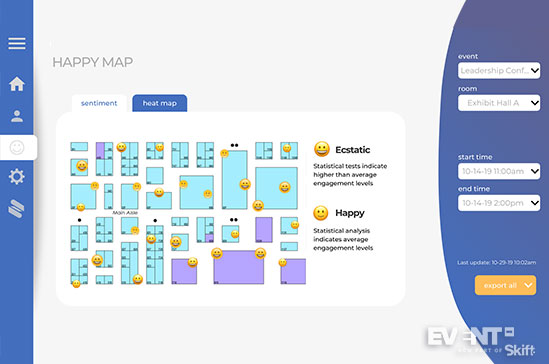

Image courtesy of Zenus
The benefits for event stakeholders are multifold.
Organizers
Event planners get to understand the exact composition of their target audience and which parts of the event have a true impact on them. They can also detect bottlenecks and places that make people ‘unhappy’, and investigate to improve the situation. Because tracking is continuous where cameras are in place, the organizer gets feedback on how people feel throughout their journey and on each touchpoint.
Moreover, the data obtained can be used to illustrate the value exhibitors obtain and thereby increase renewals and new sales. Likewise, organizers can conduct a post-show analysis to investigate which content is more relevant and for which demographics to improve the experience and increase loyalty.
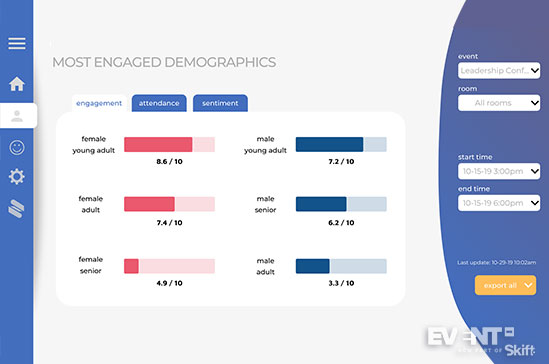

Image courtesy of Zenus
Attendees
Attendees receive a more tailored and friction-free journey. Using facial analysis to collect quantitative data throughout the event alleviates the burden of completing long surveys, and allows planners to focus on short surveys with open-ended questions. As a result, they have fewer things they have to do, and more experiences tailored to their needs/likes.
The data collected can also be used to make personalized recommendations, greetings and prompts when attendees enter an area and are recognized or are standing in front of a digital screen equipped with a camera. Each attendee feels special and appreciated.
Exhibitors
Through information on dwell time and happy maps, exhibitors obtain measurable ROI. Exhibitors can also track their performance between different shows, allowing them to understand which exhibitions are the best for their service.
Along the same lines, they can measure which demographics are the most and least engaged with their booths to adjust their activations and booth strategy accordingly.
Better Insights & Accuracy
Continuous video streams provide insights throughout the event, which is extremely useful for comparing traffic and engagement from moment to moment. You could also use facial analysis for some A/B testing by analyzing people’s attendance and reactions to different activations or sessions. You can then compare the results to determine which activation was the most successful, and proceed accordingly.
Because all the information is coming from a single source, it is also much easier to reconcile everything and get accurate analytics.
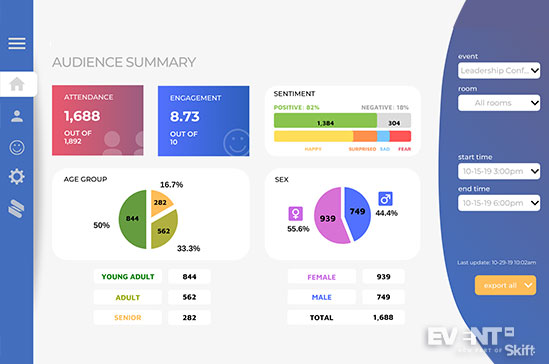

Image courtesy of Zenus
Having to integrate different sources of information together is usually a daunting, error-prone task, and can compromise your ability to leverage all the data to its full potential.
Accuracy with computer vision technology is also extremely high – around 95% – and therefore provides reliable analytics. This is partly because these systems can process a very substantial amount of information over a significant area in a short span of time, which means you get a sizable sample to draw data from. For example, if the aggregate engagement score is six (6) in one area versus nine (9) in another part of the event, the difference is big enough to draw a safe conclusion even if the accuracy is not 100%.
Logistics & Cost
Installing a single camera per room is much easier and cheaper than having to install sensors on each entrance and throughout the event, then having to add chips to badges. In general, the more software-based the solution, the more scalable it is. With facial analysis, one camera is generally sufficient to cover a large area (up to 200 by 300 feet).
Live facial analytics data reporting adds significantly to the cost because it requires more hardware on-site. Nonetheless, the price remains competitive compared with the equivalent live reports produced by RFID/BLE solutions. Moreover, the reports obtained from an AI-based solution are richer (adding demographics and sentiment data to counts and dwell time) and more accurate.
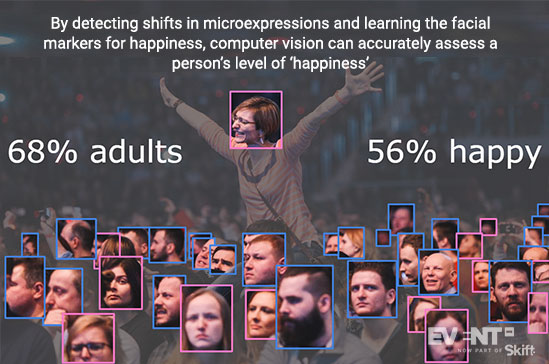

Image courtesy of Zenus
Finally, there are fewer logistical barriers, as you don’t need to distribute wearables to your guests when they check in and attendees don’t need to install any app on their phones. Because facial analysis provides aggregate insights, guests do not need to provide explicit consent either.
A facial analytics software provider such as Zenus can take care of most steps of the operation, including providing the hardware, installing it, and producing the reports. As the event organizer, you need only provide the floor plan ahead of time and discuss your key objectives.
Opportunities For Displaying Personalized Content
Almost everything online now is personalized, like when you are greeted by name upon logging into your Amazon account and they display all the products you might be interested in based on your previous purchases. The offline, on-site experience has yet to catch up. The future of improving attendee experience lies in live personalization.
There have already been experiments in which people enter their favorite department store and are greeted by name by a hostess, who then asks if they are shopping for themselves or their spouse. The hostess then offers to show them around because the store’s layout had been modified since the customer’s last visit.
Facial recognition in events (not to be confused with facial analysis) allows for creating a similar experience. Attendees who agree to provide their photo at the same time as their interests and expectations (for example during registration) can get matched to relevant exhibitors. The exhibitor can then receive a prompt when these interested prospects approach their booths and are able to greet them by name and with a tailored offer. It seems fair to assume that people who have received this VIP-like treatment from one exhibitor will probably remember that supplier more than others, who offered a less personalized experience.
Monitors around the venue could be connected to cameras that recognize people who have provided their photos, and greet them with personalized session recommendations based on the information provided during registration.
Privacy Concerns
Privacy concerns are on everybody’s mind when it comes to tech that analyses personal data such as images and other identifying information. Therefore, the protection and integrity of data should be one of the main concerns when implementing any big data or AI-powered tool.
What You Need to Know
If you use a well-established provider like Zenus, their analytics service does not extract identifiers (e.g., biometric faceprints). Rather, they perform high-level analyses to compute aggregate statistics, such as average happiness. There are no privacy implications, and therefore explicit opt-in is not required in most regions for this type of data generation. Nevertheless, in the name of transparency, you might want to inform your attendees that facial analysis cameras are in operation and that they are being used to measure engagement.
For applications that require facial recognition and identification, providers who implement privacy by design can ensure the protection of your attendee information. To this end, data separation is key. Zenus, for example, sees the person’s picture and registration number, but not their name, email address, or any other identifying information.
IN CONCLUSION
Event attendees generate a large amount of data; by using computer vision, facial analysis and artificial intelligence, event organizers can now make sense of this data, detect patterns, and gain insights that can be used to improve the event in real-time and over time.
Facial analysis technology that uses computer vision-powered data, can offer the event planner a lower cost tracking solution with a very high accuracy level and a robust way to simultaneously gather sentiment data from a crowd.
But to make the most of these (still new) technologies, it is a good idea to do a little research and pick the right vendor: one with experience in the event industry and a good reputation regarding data protection.

